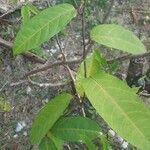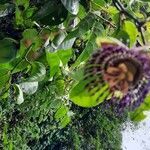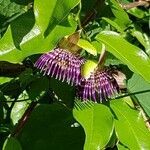Woody vines. Stem terete, glabrous, striate. Stipules linear, 3-4 mm; petiole terete, ca. 1.2 cm, sparsely pubescent, with 2 glands near base of blade; leaf blade ovate-oblong, 7-10 × 3.5-6 cm, leathery, glabrous, lateral veins 8-10 per side of midvein, base rounded or subcordate, margin entire, apex mucronulate. Inflorescence reduced to a single flower; bracts 3, ovate, 2-3 cm, puberulous, base cuneate, margin glandular serrate, apex obtuse. Pedicel 1.5-3 cm, thick. Flower white, with red spots, 5-7 cm in diam. Sepals 5, ovate-oblong, 2-2.5 cm, awned and puberulous apically. Petals 5, similar to sepals. Outer corona in 6 whorls, purple with white bands; outer 2 whorls 2-4 cm, linear; inner 4 whorls 1.5-2 mm, threadlike; inner corona membranous, apically dentate; limen annular around base of androgynophore. Ovary ovoid, sparsely pubescent. Fruit citreous or reddish yellow, ovoid, 4-6 cm. Seeds many, obcordate, 5-7 mm. Fl. Jun.
A perennial climbing vine. It can be up to 10 m long. Leaves do not have lobes and stems are round. Leaves are rounded (10 cm x 5 cm), hairless and rough. Flowers are large (6 cm across) and have a pleasant smell. Fruit are oblong and taper at both ends. They are about 8 cm x 5 cm smooth and yellow or orange when ripe. They have tough yellow skins and paler orange pulp. The fruit are edible.
Stipules thread-like, c. ½ cm; leaves ellipsoid to oblong, coriaceous; flowers c. 8 cm ø, flushed with purple or purple-dotted; corona filaments purple with white cross-bands; fruit ovoid, 5-8 cm long, edible.



